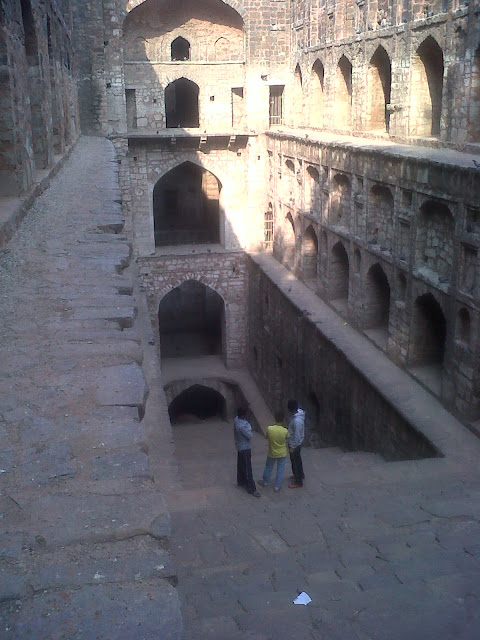I had worked in Connaught Place or Rajeev Chowk for over a decade but never knew the existence of this stunningly well preserved water Well or Baoli right in the midst of sky scrappers.
From Tolstoy Marg take the Haley Lane. Then take the first left and walk to the end of the road.
Shaded by the thick foliage, the Well measuring 60 meters in length and 15 meters in width was built to cope with the seasonal fluctuations of paucity of water. The date of construction of the well is shrouded in the mists of time.
It is believed to have been built by Raja Ugrasan or Agrasan, the forefather of the Aggarwal community. It has all the appearance of the architectural style of the Indian medieval period. Historians however surmise that the well may have been built even before this period.
The bore of the well can be reached as you descend to the lowermost steps of the well. The diameter of the well is at least 6 meters and descends equivalent to 3 stories of a modern day structure.
At the entrance of the Baoli is small mosque. Is this an another example of Hindu-Muslin communal harmony coming down to us through the ages?
Very few visitors come here. Scores of pigeons stand and watch silently. Once upon a time the well was a source of water to quench the thirst weary travellers passing through Delhi.
From Tolstoy Marg take the Haley Lane. Then take the first left and walk to the end of the road.
Shaded by the thick foliage, the Well measuring 60 meters in length and 15 meters in width was built to cope with the seasonal fluctuations of paucity of water. The date of construction of the well is shrouded in the mists of time.
It is believed to have been built by Raja Ugrasan or Agrasan, the forefather of the Aggarwal community. It has all the appearance of the architectural style of the Indian medieval period. Historians however surmise that the well may have been built even before this period.
The bore of the well can be reached as you descend to the lowermost steps of the well. The diameter of the well is at least 6 meters and descends equivalent to 3 stories of a modern day structure.
At the entrance of the Baoli is small mosque. Is this an another example of Hindu-Muslin communal harmony coming down to us through the ages?
 |
| The oblique rays of the mid-day sun beating down on the Baoli. |
Very few visitors come here. Scores of pigeons stand and watch silently. Once upon a time the well was a source of water to quench the thirst weary travellers passing through Delhi.
 |
| There are 104 steps leading down to the well. |
 |
| The Baoli is remarkably well preserved. There is hardly any signs of dilapidation. |
 |
| Standing at the second level of the Baoli. |
 |
| The final arch that leads to the bore of the well. |
 |
| Picture of the roof, taken from the base of the steps. The rays of the zenithal sun can be seen. |
 |
| The narrow stair cases leading to the sides of the Baoli. |















No comments:
Post a Comment